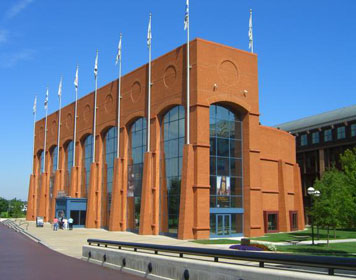Subscriber Benefit
As a subscriber you can listen to articles at work, in the car, or while you work out. Subscribe NowCelebrated architect Michael Graves, an Indianapolis native who designed some of the city’s signature buildings from the late 20th century, died of natural causes on Thursday. He was 80 years old.
Born in Indianapolis in 1934, Graves enjoyed an architecture and design career that spanned the globe. He created whimsical postmodern structures and became well known to the masses later in life for designing products for people with disabilities and household goods such as whistling Alessi teakettles and stainless steel colanders for sale at Target and other stores.
But he made his name in the 1980s as one of the popularizers of a new kind of architecture, admirers of his work said.
“Michael Graves was a kind of giant of the period of architecture called postmodernism, when architects around the 1980s looked back to European design precedence,” said Pauline Saliga, the director of the Society of Architectural Historians. “They kind of rejected the sterility of modernism. They were looking for other design inspirations.”
Graves designed buildings all over the world. But his most famous structures may be The Portland Building, the city administrative building in Portland, Oregon, and The Humana Building, a 26-story skyscraper in Louisville, Kentucky.
Those buildings, which opened in 1982, and others used a variety of colors and shapes and have sometimes eccentric juts in and out a little like Lego creations.
In Indianapolis, his projects included the Thomson Consumer Electronic headquarters (1992), the NCAA Hall of Champions (1997), and the Indianapolis Art Center (1996).
President Bill Clinton awarded Graves the National Medal of Arts in 1999, and the American Institute of Architects gave him its gold medal, the highest award for an architect, in 2001.
Chicago-based architect Stanley Tigerman, who was a contemporary and friend of Graves, called him one of the best-known postmodernists.
“To me, Michael was always generous, sweet, kind,” Tigerman said. “He brought back imagery and symbolism.”
Later in life, Graves started designing signature household items such as teakettles and colanders for Target stores. He later had a line at JCPenney as well.
Those items brought a famous architect into the kitchens and bathrooms of millions of homes.
Graves’ Alessi kettle, introduced in 1985, features a spout with a bird that sings when the water boils. It’s part of a series of Alessi-style items including pitchers and kitchen timers that have been very popular sellers.
In 2003, Graves was paralyzed from the waist down from an infection. He used a wheelchair for the rest of his life.
After the illness, he began a third career, designing for people with disabilities. He designed items including a wheelchair, heating pads and bathroom handrails and accessible homes for the Wounded Warrior Project.
He was recognized by another president for this work when President Barack Obama named him to the United States Access Board in 2013.
Graves graduated from Broad Ripple High School in Indianapolis in 1952. He studied architecture at the University of Cincinnati and Harvard University. He won the Rome Prize in 1960 and spent two years studying in Italy.
After he returned to the U.S., he began a four-decade career teaching at Princeton University.
Over his career, he also designed a campus master plan for Rice University in Houston and designed the Swan and Dolphin Resort at Walt Disney World, among other buildings.
In a statement, his firm, Michael Graves Architecture & Design, based in Princeton and New York, said it would carry forward his traditions.
“Of all of his accomplishments, Michael often said that, like his own family, his proudest creation was his firm,” the firm said. “As we go forward in our practice, we will continue to honor Michael’s humanistic design philosophy through our commitment to creating unique design solutions that transform people’s lives.”
Please enable JavaScript to view this content.

